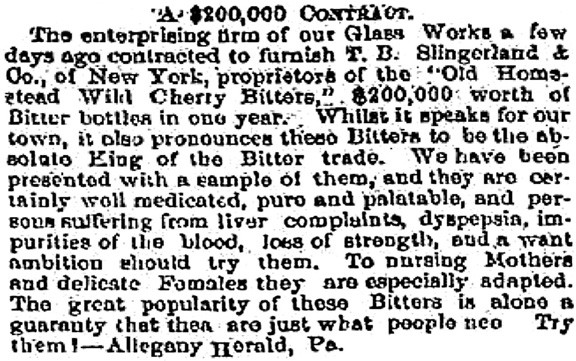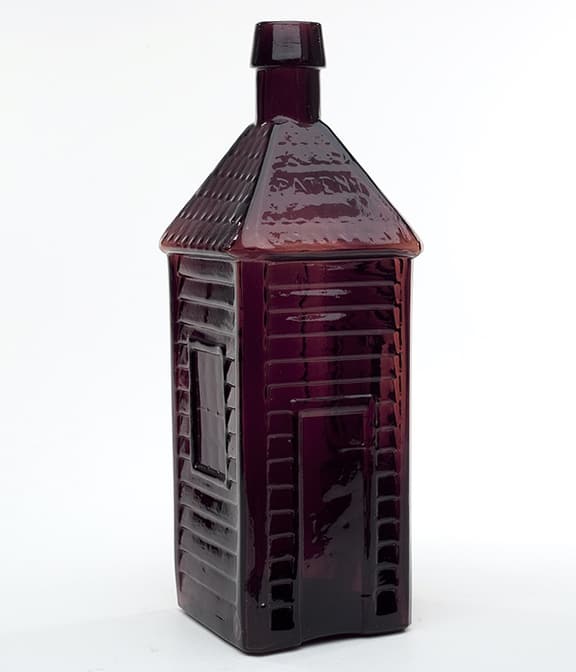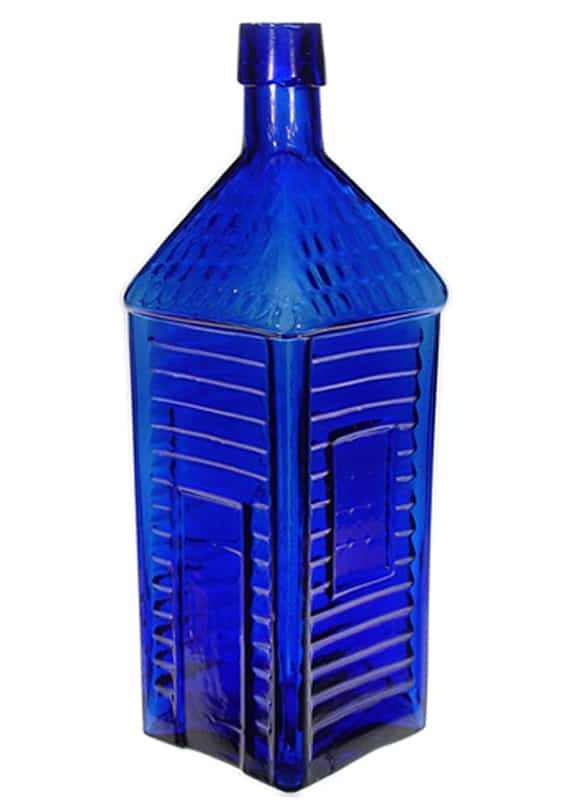Log Cabin Series – Old Homestead Wild Cherry Bitters
24 November 2012 (R•052814) (R•031817) (R•101818) (R•111218)
OLD FOLKS AT HOME!
O L D H O M E S T E A D
W I L D C H E R R Y B I T T E R S
Patronized by the medical profession, the military hospitals, as well as the bar, the saloon and the sideboard, they supply the desideratum so long demanded by the public as the Universal Friend.
![]() With the holidays, it is finally time to do a comprehensive series on figural log cabin bottles. And wow, what a way to start with the widely popular Old Homestead Wild Cherry Bitters. As Wisconsin collector, Jeff Burkhardt reminds us, technically it is not a log cabin, but a clapboard-sided house bottle. None-the-less, it will be our starter and the Old Homestead is certainly grouped as a figural cabin.
With the holidays, it is finally time to do a comprehensive series on figural log cabin bottles. And wow, what a way to start with the widely popular Old Homestead Wild Cherry Bitters. As Wisconsin collector, Jeff Burkhardt reminds us, technically it is not a log cabin, but a clapboard-sided house bottle. None-the-less, it will be our starter and the Old Homestead is certainly grouped as a figural cabin.
Old Homestead Wild Cherry Bitters was trade marked in June 1863 by George Scott from Rome, New York. His design was patented in 1864 and was marketed by Thomas B. Slingerland & Company. They were partners.
George Scott was born in England in 1827 and was one of Rome, New Yorks oldest and best known residents. He came to the United States as a young child with his parents. The family located in Troy, New York. As a teen, young Geoge learned the printing trade from Horace N. Bill, who at that time published the Old Roman Citizen. After completing his apprenticeship, he and Alfred Sandford purchased the paper, their firm being called Sandford & Scott.
He later disposed of his interest in the paper and entered the drug business and located on Dominick Street in Troy eventually becoming the sole owner of a drug store. After a few years, he disposed of this business and moved to New York City and opened up a drug store on Beekman Street. While in New York, he perfected the formula for Old Homestead Wild Cherry Bitters, and returning to Rome, began its manufacture and sale on an extensive scale, partnering with Thomas Butler Slingerland. Their headquarters in Troy was on South James Street opposite Stanwix Hall. Slingerland was primarily a tobacco and cigar dealer.
With the death of his partner in the mid 1880s, Scott left the drug store concern and entered the real estate business. Later he would file a lawsuit against the Slingerland estate.
THOS. B. SLINGERLAND
Manufacturer and Jobber in
Patent Medicines, Havana Cigars
Old Homestead Wild Cherry Bitters come in a wide variety of drop-dead gorgeous colors such as the lemon yellow example pictured below which was previously sold by Ed and Kathy Gray with GreatAntiqueBottles.com.
There are a number of variants of the Old Homestead bottle which include 12 pane and 15 pane windows of which I can not find a good picture of the 15 pane variant. There is an illustration of the 15 pane variant in Bitters Bottles. There are also variants with the door ending above the base and another with the door going to the bottom of the bottle. You will see examples in this post. You will also see the ‘best of the best’ Old Homestead examples including the cobalt blue example and the emerald green example with the inside screw top. These examples are considered among the top bitters bottles.
Note: I am looking for advertising and labeled examples for this post.
“To the above are added Clove Buds, Orange, Carraway, Coriander and Snake Root. The whole is combined by a perfect chemical process, and under the immediate supervision of a skillful and scientific Pharmaceutist…are put up in patent bottles, representing a Swiss cottage, and are an ornament to the sideboard.”
New York Times, June 28, 1862 (Referencing Drake’s Plantation Bitters and Old Homestead Tonic)
What is interesting in the above advertising text is the reference to a Swiss cottage and the obvious use of a cabin figural form to be pleasing to the eye when placed in a sideboard.

The style of Ebenezer Zane’s Old Log Cabin reminds me of the Old Homestead Wild Cherry Bitters form. The first building erected in Wheeling built 1769, torn down 1908. This is the cabin to which Elizabeth Zane made her heroic dash for powder during the siege of Ft. Henry by the British and Indians. Postmarked 1909. – Historic Wheeling Wiki
The Carlyn Ring and W.C. Ham listing in Bitters Bottles is as follows:
O 37 OLD HOMESTEAD WILD CHERRY BITTERS, circa: 1860 (1863) – 1875
// s // OLD / HOMESTEAD / WILD CHERRY / BITTERS. // motif of shingles // PATENT // sp // motif shingles //
9 7/8 x 2 7/8 x (5 7/8) 3/16. Square cabin, LTC, Applied mouth, Amber, Common; Yellow, Lime, Puce and Olive yellow, Rare; Cobalt Blue, Extremely rare; Green and Amber with inside screw and glass stopper, Extremely rare.
T. B. Slingerland & Co., No 69 Beekman Street, New York
Label: Compounded from wild cherry bark and fruit, Jesuit’s bark, Prairie Red Bloom, Madaril Indian Orientalis and several other choice strengthening, purifying and life-giving medicinal agents, forming the most helpful and pleasant beverage, stimulating tonic, and cleansing bitters for improving the appetite giving tone and vital energy to the blood and system, unsurpassed for medicinal purposes for hotels, voyagers, family use etc.
These bitters are in an eminent degree strengthening, purifying, diuretic, stimulating and nourishing to the whole system, giving new life and activity to every organ and part alike, without that ever recurring reaction that follows the use of all other tonics and stimulants ever before discovered.
As a morning appetizer, no other tonic or stimulant in the universe can equal them. For disordered digestion, imperfect circulation of the blood and exhausted vital energy, they give permanent and prompt relief. They nourish the blood, replenish the system, and every nerve and muscle is made to fulfill its natural functions.
No beverage or stimulant has ever given such universal satisfaction. Patronized by the medical profession, the military hospitals, as well as the bar, the saloon and the sideboard, they supply the desideratum so long demanded by the public as the Universal Friend.
Trade Mark No. 3307, dated June 1863 by George Scott, Rome, New York. Design patented 1864.
Note: There are a number of variants of this bottle which include 12 pane and 15 pane windows with door ending above the base and going to bottom of the bottle. The Cobalt blue example, and the Emerald green with inside screw top example are considered among the top bitters bottles. Letterhead dated February 23, 1869, T. B. Slingerland, Rome NY.
Read: A couple of great Old Homesteads show up in Baltimore
The Bottles
“Whitney glass works had a huge presence in the city of New York in the mid 1800’s. The glass works clientele list of 1865 shows a Whitney Patent inside screw stopper for this bottle. It would be safe to assume that if they were producing inside screw stopper enclosures for this bottle that they would have access to the mold for the bottle as the tops were usually LTC type. I can’t see them importing topless bottles to put their inside screw stoppers on them. Although rare the bottle does exist. I also believe that they were produced in the Lancaster glass works in New York state and this alone explains the different colors we sometimes see in a lot of the bitters bottles.” – Steve Sewell (antique-bottles.net)

Newspaper clipping about a glass contract for Old Homestead Wild Cherry Bitters. It doesn’t specifically state the glass works but I believe they are referring to Pittsburgh (McKee & Brother(s)) – Brian Wolff
Collateral Pieces

Receipt reading Bought of T.B. Slingerland & Co., No. 69 Beekman Street, N.Y. – Old Homestead Wild Cherry Bitters, dated September 22, 1864. Reads: Receipt for, ‘4 Doz. Old Homestead Wild Cherry Bitters, 8.50 | 34.00’. – Meyer Collection
GALLERY

[door going to bottom of the bottle] OLD HOMESTEAD WILD CHERRY BITTERS in a bright golden amber shading to light yellowish honey along the lower roof lines, square cabin form, applied sloping collared mouth – smooth base, ht. 9 ¼”, very near mint; R/H #O37. A bright, pretty example, lighter than normal, with nice strong embossing. – American Glass Gallery Auction #9

[door ending above the base of the bottle] OLD HOMESTEAD WILD CHERRY BITTERS in yellow amber – Meyer Collection

The only OLD HOMESTEAD WILD CHERRY BITTERS in dark green with screw cap – photo Bitters Bottles Supplement

Just an AMAZING Old Homestead Wild Cherry Bitters in WILD CHERRY! “OLD / HOMESTEAD / WILD CHERRY / BITTERS – PATENT”, America, 1865 – 1875. Gorgeous, medium-to-deep strawberry puce, cabin form, applied sloping collar – smooth base, ht. 9 3/8”, virtually attic mint; (a couple of tiny pinprick specks of roughness on the edge of the lip, otherwise perfect). R/H #O37. An extremely rare and desirable color, it has been more than 20 years since another example has been offered at auction. Provenance: Joe Kray collection, purchased at Cherry Hill, NJ Nat’l, 1994. Absolutely no amber is this one, a fabulous color. – American Glass Gallery

Four OLD HOMESTEAD WILD CHERRY BITTERS lined up in the legendary windows of the John Feldmann collection

Considerably bright window shot of two legendary OLD HOMESTEAD WILD CHERRY BITTERS. The emerald green example is now in the Sandor Fuss collection. The lemon yellow example is in the Bill Taylor collection. Note inside screw and glass stopper for the emerald green example.

























Those are amazing colors and wonderful bitters bottles…Thumbs up. Thanks for sharing them here..
P.S. Is the puce one damaged? I wonder if it was dug that way? Perhaps my eyes are playing tricks on me……..
Most likely that invoice of T. B. Slingerland & Co. for those four cases of bitters was sold to that buyer at wholesale price. Those 48 bottles cost just over .70 cents a piece. In all my research on western glass I’ve never been able to pinpoint what the glass factories charged for manufacturing bitters bottles. Other bottles such as pickles, sodas, wine, brandy, etc. but not specifically bitters. I haven’t seen a retail price for a Homestead bitters, but I would guess that it retailed for $1.50 a bottle when it was marketed.
To Joethecrow- I believe Jack’s example is cracked(recently sold at Keene show), but there are probably 5 known mint/nr. mint examples of the Homestead in PUCE.
I find the form interesting because, technically it’s not a log cabin, but a clapboard-sided house bottle.
Ahh the cabin series… i’ve been looking forward to this F! By the way those green Old Homesteads are insane! =)
~Tim